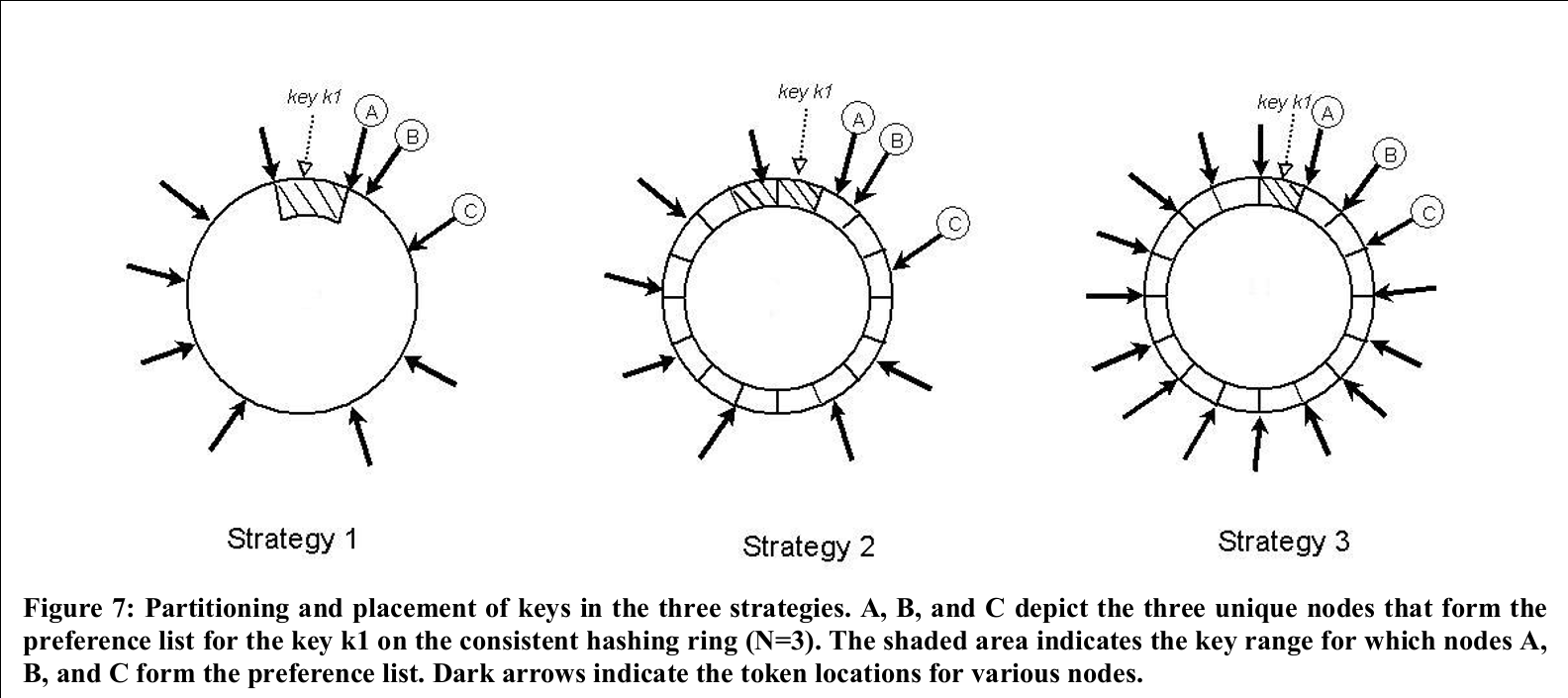Dynamo Paper Review
Dynamo: Amazon’s Highly Available Key-value Store
Buzzwords
Highly decentralized, loosely coupled, service-oriented architecture
Consistent Hashing
- virtual nodes
Quorum-like technique
- R + W > N
Decentralized replica synchronization protocol
anti-entropy (replica synchronization) protocol
a big word for synchronizing two replicas
Merkle tree
Object versioning
syntactic reconciliation
new versions subsume the previous version(s), and the system itself can determine the authoritative version
semantic reconciliation
the reconciliation in order to collapse multiple branches of data evolution back into one
vector clock
Gossip-based distributed failure detection and membership protocol
Eventually-consistent storage system
Service level agreements(SLA)
Application level update conflicts resolution
Preference list
- The list of nodes that is responsible for storing a particular key
Coordinator
Hinted Handoff
Stage event-based architecture(SEDA)
Dynamo’s partitioning scheme’s three stages

T random tokens per node and partition by token value
T random tokens per node and equal sized partitions
Q/S tokens per node, equal-sized partitions
Coordination
Client-driven
Server-driven(load balancer)
Summary
The paper introduces an eventually consistent distributed, application-level conflicts resolution K/V database which focuses that write never fails called Dynamo. Dynamo is much like PNUTS with eventual consistency while PNUTS uses per-record-timeline consistency to ensure one order. Moreover Dynamo is much like Bayou with its application-level resolution while Bayou may rollback writes.
Dynamo is built for Amazon’s e-commerce platform which guarantees service level agreements purely targeting at controlling performance at the 99.9th percentile. So Dynamo mainly focuses on the performance and availability(“always writable”) instead of consistency and durability.
The paper introduces the architecture in several core components:
- Partition && Replication
The Dynamo uses consistency hashing to partition the storage with
virtual nodes for uniform distribution. Moreover, the each hashed key is
replicated on several successor nodes and all nodes contain the key are
called perference list of the key. The coordinator (who accept the
put/get from clients) then forwards the all from clients to the nodes
in the list. The consistent hashing is decentralized and almost balanced
due to virtual nodes, while data may need to be shift to other nodes when
new nodes join/leave the system. Dynamo treats all failure as temporary
and only make changes when explicitly add/remove nodes and the operation should take
a long time.
- Data Versioning
Because of eventual consistency and always writable requirements,
divergent replicas need to be resolved. Dynamo allows multiple versions
between the replicas and use vertor clock and application level
resolution to resolve the conflicts. For example, the case of shopping
cart uses union which may result in no lost ‘add to chart’ while may
cause deleted one to resurface.
- System API
Dynamo only supports put/get. There are two ways of routing. The first
one is using load balancer, which transfer the request to load
balancer, and load balancer transfer it to a random node, and then
the node will forward according to the preference list. The second one is
just linking it to a client library which will transfer the request to the
appreciate node.
Dynamo uses sloppy quorum and hinted handoff to achieve always
writable requirements.
The sloppy quorum means that with R(node reply to the client only R
replicas replies), W(node reply to the client only W-1 replicas replies),
N(first N reachable nodes in reference list) and quorum rule that R + W
> N, there will be an overlap between R and W, so Dynamo can promise
consistency.
The hinted handoff means that when first N nodes in the reference list are
unreachable, we may need to use other nodes to record the temporary data
and transfer the data when the node is reachable again. This technique
may result in some inconsistency while improving the availability.
Due to failure, replicas may become unsynchronized, Dynamo uses the
Merkle tree (hashing based tree) and gossip protocol as the anti-entropy
protocol, which can reduce the data necessary for transfer.
- Membership
According to the paper, a gossip-based protocol propagates membership changes and maintains an eventually consistent view of membership. So some inconsistency may be introduced. For example, the deleted server might get puts meant for its replacement and added server might miss some puts because not known to the coordinator.
- Design experience
Dynamo’s consistent hashing design experiences evolution. The old scheme is randomly partitioned which requires the scan(O(n)) to split the range of the nodes. And the new scheme just uniformly divided the circle into Pre-determined set, and transfer the ranges for simplicity and performance.
Strength of the paper
An awesome system that makes use of lots of algorithms aimed at special questions and mixes them smoothly to build Dynamo.
The always writable model is meaningful to the application such as Amazon due to SLA for the 99.9th percentile.
Nice experience introduction of how and why design evolves.
Weakness of the paper
- Comparison between the design of P2P and single master may be necessary for why amazon decentralized architecture.